16 January 1762
from James Adam to Robert Adam
Piranesi is advancing the Campus Martius as fast as the distressed situation of his private affairs will allow him, being at present extremely distressed with the irregular conduct of his wife, who, as we say in Scotland, has been too great with another man and so he has put her in a convent for her amusement.
16 January 1778 Friday
Vases, Candelabra, Grave Stones, Sarcophagi. Tripods, Lamps and Ancient Ornaments volume I
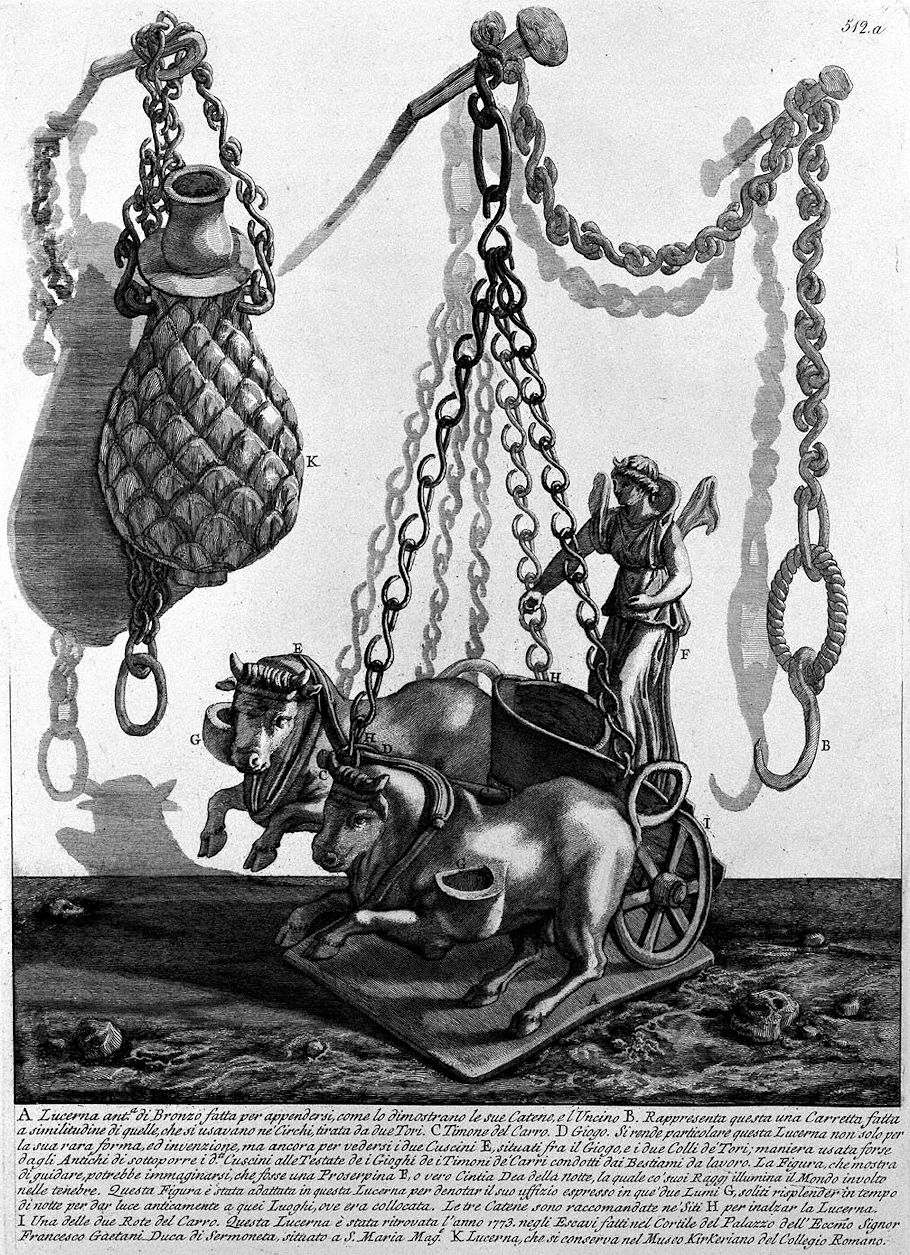
Two hanging bronze lamps.
A Bronze lamp front made for hanging, as demonstrated by its Chains, and the Hook B. This represents a Cart made in the likeness of those used in the Circuses, pulled by two Bulls.
C Rudder of the Chariot. D Yoke. This Lamp is particular not only for its rare form and invention, but also for seeing the two Cushions E, located between the Giogo and the two Colli de' Tori; manner perhaps used by the Ancients to submit the d.ti Cushions to the Heads of the Yokes of the Rudders of the Carts driven by the Working Livestock. The Figure, who appears to be driving, could be imagined to be a Proserpina F, or true Cintia Goddess of the night, who with her Rays illuminates the World enveloped in darkness. This Figure has been adapted in this Lamp to denote its office expressed in those two Lights G, which used to shine at night to give light in ancient times to those Places where it was located. The three Chains are recommended in the H Sites to raise the Lamp. I One of the two Cart Wheels. This Lamp was found in the year 1773 in the excavations made in the Courtyard of the Palace of the Most Excellent Mr. Francesco Gaetani Duke of Sermoneta, located in S. Maria Mag.e K Lamp, which is kept in the Kirkerian Museum of the Roman College.
16 January 1812 Thursday
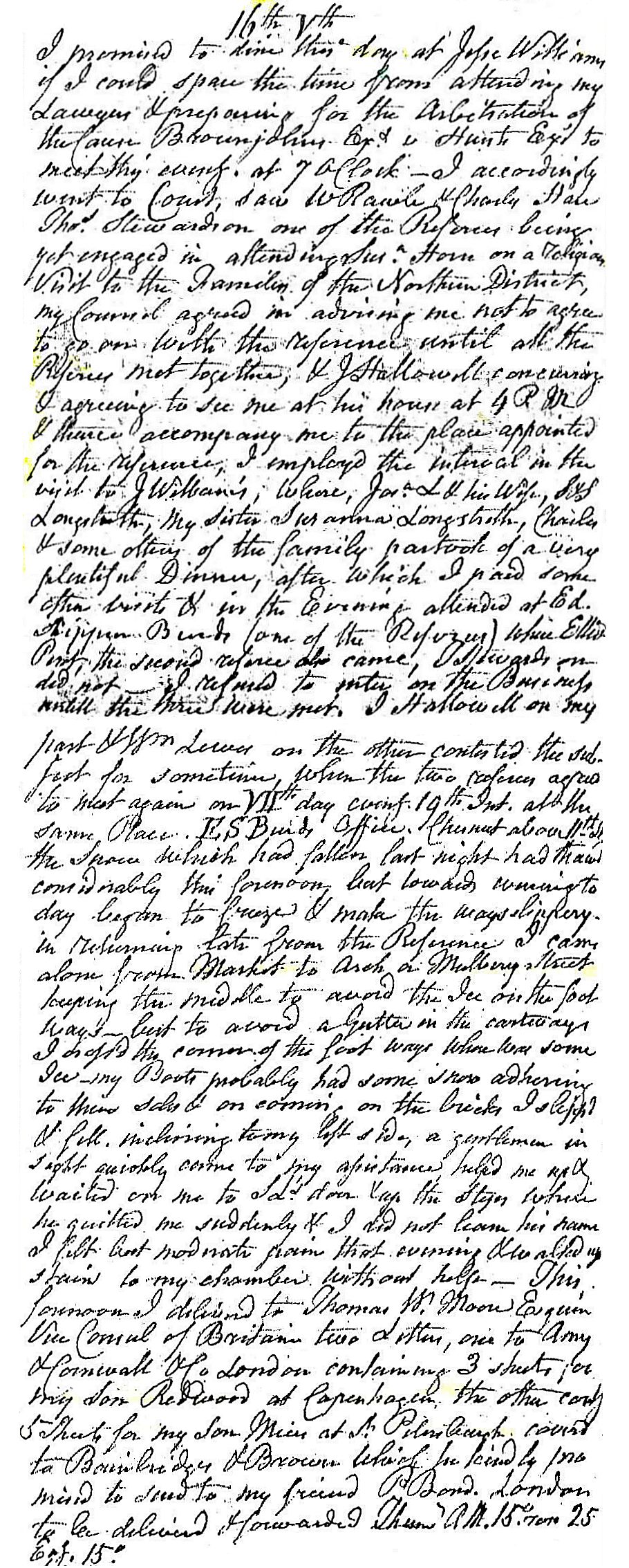
I promised to dine this day at John Williams if I could spare the time from attending my lawyers & preparing for the arbitration of the cause Brownjohns Ex[?] v. Hunt Ex[?] to meet this evening at 7 o'clock. I accordingly went to Court, saw W. Rawle and Charles Hare. Thomas Stewardson one of the referees being yet engaged in attending Sue a[?] Horn on a religious visit to the family of the northern district. My council agreed in advising me not to agree to go on with the referenee[?] until all the referees met together, and J Hallowell concurring and agreeing to see me at his house at 4 PM and thence accompany me to the place appointed for the referenee[?]. I employed the interval in the visit to J. William's where Joshua L and his wife, S and S Longstreth, my sister Susanna Longstreth, Charles and some others of the family partook of a very plentiful dinner, after which I paid some other visits and in the evening attended at Ed. Shippin's B..... (one of the referees) where Elias P...t, the second referee also came. T. Stewardson did not--I refused to enter on the business until the three were met. J Hallowell on my part and Wm Lewis on the other contested the subject[?] for sometimes when the two referees agree to meet again on Saturday evening 19th Int.[?] at the same place. ES Bird's[?] office Chestnut above 11th St.
The snow which had fallen last night had thawed considerably this forenoon but towards evening today began to freeze and make the ways slippery. In returning late from referenee[?] I came alone from Market to Arch or Mulberry Street keeping the middle to avoid the ice on the footways--but to avoid a gutter in the cartways I crossed[?] the corner of the foot ways where was some ice--my boots probably had some snow adhering to their soles & on coming on the bricks I slipped & fell, inclining to my left side. A gentleman in sight quickly came to my assistance, helped me up & waited on me to SL’s door and up the steps where he quitted me suddenly & I did not learn his name. I felt but moderate pain that evening & walked upstairs to my chamber without help. -- This forenoon I delivered to Thomas W. Moore Eq..... Vice Consul of Britain two letters, one to Amy & Cornwall & Co. London containing 3 sheets for my son Redwood at Copenhagen, the other containing 5 sheets for my son Meirs at St. Petersburg cover to Bainbridge & Brown, which he kindly promised to send to my friend P. Bond, London to be delivered & forwarded. Therm. AM 15° rose 25, evening 15°.
16 January 1999
eros & thanatos
After searching my Timepiece notes for something on metabolism, I (re)found Freud's quotations from Civilization and its Discontents which names eros and thanatos (the life and death instincts) as the basic operations of life. The whole notion is great for my idea of a metabolic imagination and it didn't take me long to make the connection to the Life and Death axes of the Campo Marzio.
16 January 2002
more on Ambrose and Theodosius, etc.
The first paragraph below was sent as part of another email post on a list primarily made up of architects. Following this paragraph are further comments addressed to lt-antiq listers.
For those interested in what may well be the turning point in Western civilization when the Church began wielding more power than the ruling Imperials, see www.quondam.com/03/0291.htm and the two pages that follow. These pages describe the double theater of power between Ambrose (Bishop of Milan) and the Emperor Theodosius during the later years of the fourth century. Two events are here described, a Christian terrorist attack on a Synagogue, and a brutal massacre of over 7000 innocent people within a stadium/circus at Thessalonica. Theodosius was the last emperor to solely rule over the entire empire, and during his reign Christianity became the empire's official and only religion. It is within Ambrose's obituary of Theodosius that the [his]story of Helena's finding of the True Cross is for the first time spoken of publicly after almost sixty years of imperially enforced silence.
I have become 95% (if not virtually completely) convinced that the "silence" surrounding Helena's finding of the True Cross was manifest by a Constantinian "command". Although I have long held to this hypothesis, there just wasn't enough circumstantial evidence to allow me to make a case. This changed however when I became aware of the TYPE of Constantine III (who is more commonly known as Constans II), a mid-7th century law that forbade further discussion of the possible one or two wills and energies of Christ. Constans II had an empire that was becoming interiorly divided over theology, while the rise of Islam was now a definite threat to the empire from without. The TYPE was essentially issued to strengthen the unity of the empire from within, and thus presenting a stronger front to invading Muslims. Interestingly, Byzantine chronicles never mention the TYPE, and it is only from Lateran records that the TYPE and the gist of its contents is known. Of course, it is impossible to see the TYPE as a precedent to the "silence" ordered by Constantine I, but it does at least validate the notion that 'laws of silence' have existed.
There are actually a number of uncanny (and even inverted) coincidences between the reign of Constantine I and Constantine III, not the least of which is how Christianity under Constantine I became the oppressor of paganism, while Christianity under Constantine III became the victim of Islam. There is also much similarity of 'hair-splitting' within the debates of Arianism and those of Monotheletism. If there indeed was a "law of silence" issued by Constantine I regarding Helena and her finding of the True Cross, then it was Ambrose that 'officially' (and perhaps most intentionally) broke this law when he spoke of this subject publicly as he delivered the obituary of Theodosius. What makes this supposition even more interesting is that Ambrose had already been actively breaking down the core of imperial power, as the above mentioned episodes between Ambrose and Theodosius clearly demonstrate. And upon reflection of what Ambrose actually accomplished in terms of greatly strengthening the power of the Church largely at the expense of imperial power, it occurred to me just why Constantine I ordered the silence. Given the fact that Cross was discovered within the same year that Constantine had to kill his own son, and also seems somewhat responsible for the death of his wife, to then allow public acknowledgement of the True Cross and the 'Higher' power it implied would only really mean Constantine's own demise, and hence the demise of the entire imperial power structure (which up to this point Constantine worked very hard to reestablish).
If you believe that there was an enforced silence regarding Helena's discovery of the True Cross, then you should also believe that the silence worked in terms of keeping imperial rule firmly established. That is, until Ambrose and Theodosius.
16 January 2003
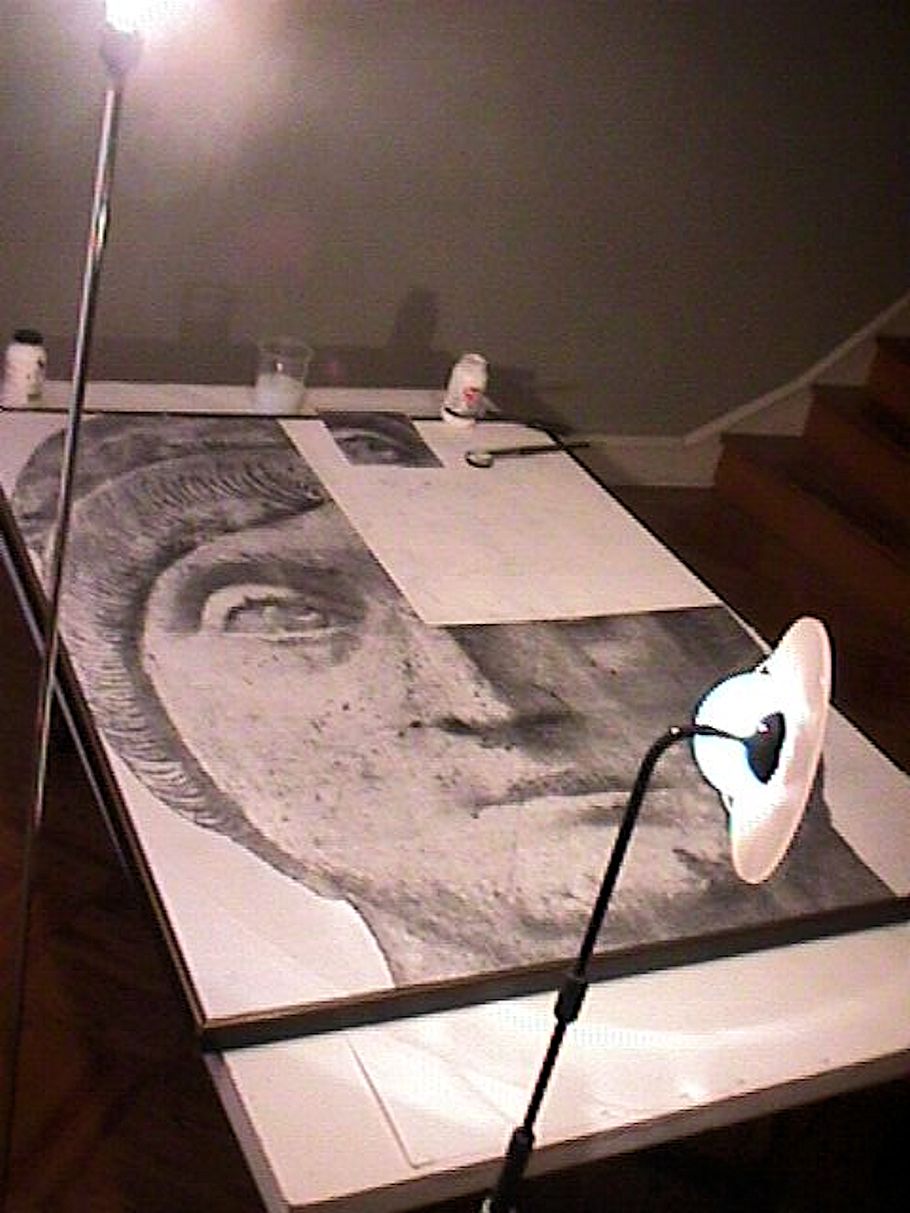
making of [Dropping the So-Called] Heilige Helena
16 January 2022
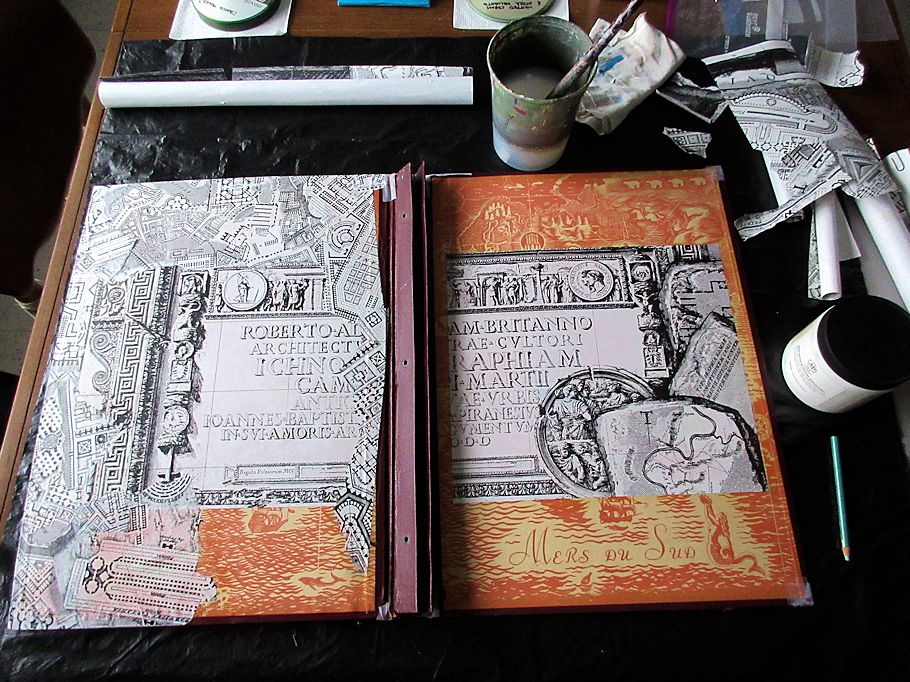
16 January 2023 Monday
permit me to indulge:
Being an architect is perhaps the primary reason I discovered Piranesi's final project, specifically an architect enamored with building floor plans. The original game board of Clue is the first plan I ever saw. My first "Aha!" moment, you might say.
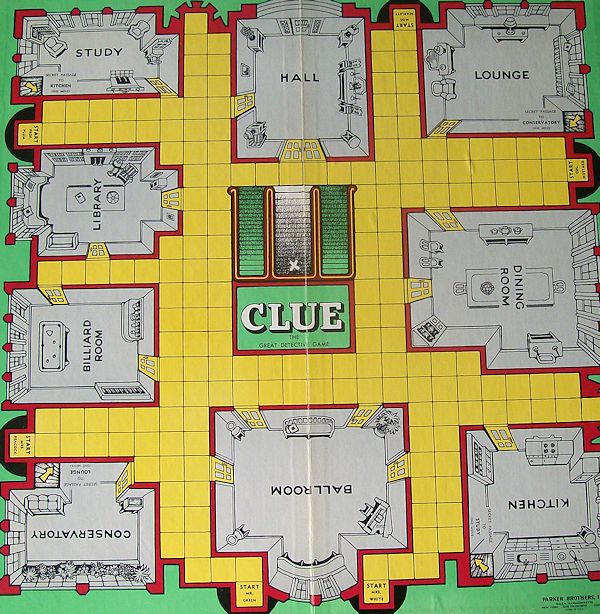
The second plans I ever saw were contemporary house floor plans in a brochure on the table of the lobby seating area of Olney Federal Savings and Loan's brand new bank building, circa 1960-1. Of course, at four or five years old, I had no idea I was sitting in genuine Barcelona chairs while enamored with floor plans in a mortgage brochure picked up off a genuine Barcelona table. Very Glass House living room, even.
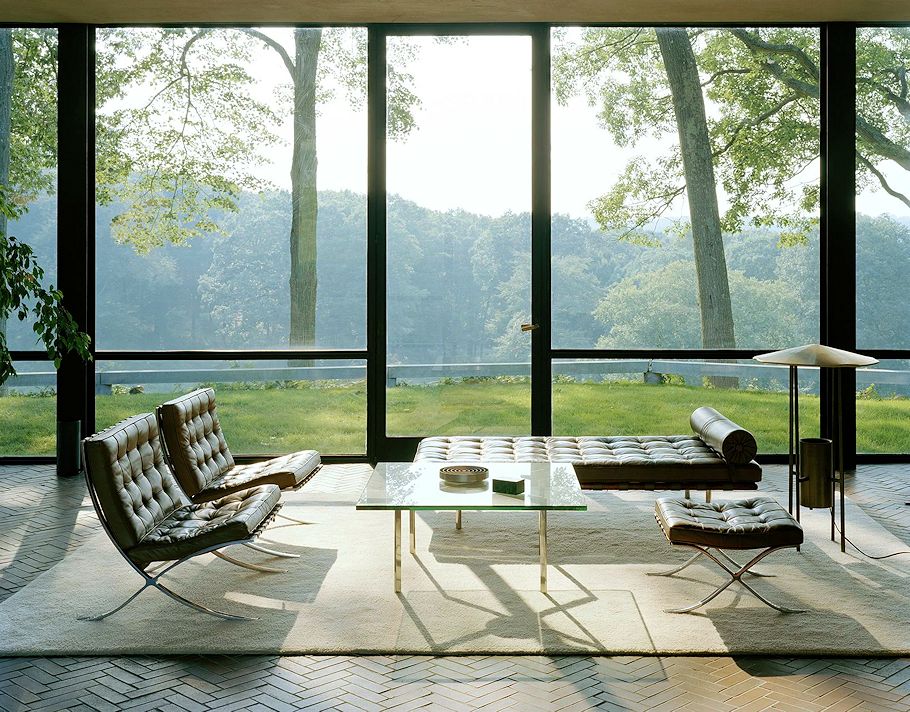
Eirik Johnson
|